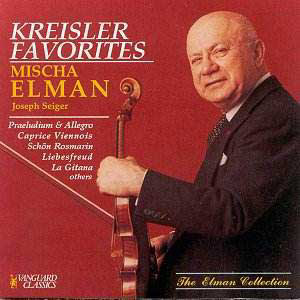The first fourteen tracks date from a Vanguard session
in 1960 and the last two from a late recording in 1966. This Kreisler
album followed Mischa Elmanís Jubilee Album of 1959 and was to be followed
by other records of solo pieces as well as concerto performances; a
Khachaturian concerto in Vienna was spicy and intriguing repertoire
for Elman, though one should never forget that he was dedicatee of a
Martinu Concerto (the premiere is fortunately preserved on Music and
Arts). Vanguardís producer Seymour Solomon had faith in Elman when others
had long grown tired of the ageing violinist in favour of younger talents
and itís entirely to Vanguardís credit that they gave Elman the opportunity
to commit so much to disc. No Elman disc is without interest of some
kind and few of these Vanguards are devoid either of points of contention.
The deterioration in manual dexterity and concomitant
technical and tonal qualities afflicts most violinists in their sixties
but this is especially so in the case of Elman where the disparity between
the voluptuous sensuality of his tone in the teens and twenties of the
century and the increasingly strained and starved tonal resources of
the now septuagenarian violinist are immediately apparent. In Liebesfreud
he is affectionate but with very deliberate articulation and somewhat
point making. The Slavonic Dance No 2 in the DvořŠk-Kreisler
arrangement is again solid in tempo but also accompanied by some still
luscious sound and glamorous finger position changes. He aspires to
sultry playing in La Gitana but the molten core is no longer there and
at this tempo the vital narrative is dissipated not intensified
and as a result the piece emerges as enervated and unvital. The Beethoven
Rondino was dedicated by Kreisler to Elman and the dedicatee plays it
with directness and simplicity but he makes a surprising meal of the
phrasing in Caprice Viennois Ė itís not at all spicy, very slow, and
reluctant to indulge sensuality. The Malaguena in the style of Granados
is new to the Elman discography, having never before been issued. Itís
good to have, of course, but not outstanding. His passagework in the
Corelli Variations is laborious and there are some extraneous bowing
noises in the restatement of the theme but in spite of all these limitations
Elmanís playing retains a patrician, rather reserved, charm that I find
very attractive. He puts on the mute for the Preghiera for 3Ĺ minutes
of raptly devotional playing whereas the Sicilienne episode of the Sicilienne
and Rigaudon is unfortunately rather penny-plain and his subsequent
G string passage rather predictable and gestural and more Elman than
Kreisler. In the Praeludium and Allegro Elman breaks the melodic line
and elevates incident above architecture, something of a besetting feature
of aspects of his playing, and one that damages the piece beyond saving.
It begins in a very detached manner, very, very slow and didactic, with
an unconvincing attempt at internal drama, altogether overblown and
disappointing. The Andantino in the style of Martini is another previously
unreleased performance Ė using the mute again he is more than a little
ponderous. The two final pieces yield 1966 performances; the acoustical
change is palpable. We can now hear the increasing deterioration of
the violinistís tone and technique Ė there is an astringency to the
sound that sends one back to those Victors of a half-century before
with gratitude for all that this remarkable musician had achieved in
his long life.
Jonathan Woolf


